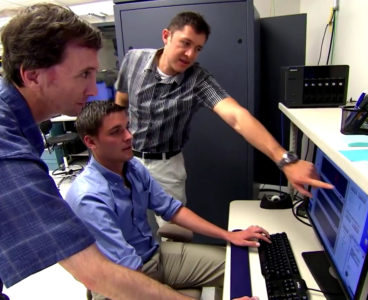Quantum computing is a term that periodically flashes across the media sky like heat lightning in the desert: brilliant, attention-getting and then vanishing from the public’s mind with no apparent aftereffects. Yet a multimillion dollar international effort to build quantum computers is hardly going away. And now, four new projects led by Sandia National Laboratories…
Friendly Electromagnetic Pulse Improves Survival for Electronics
Lasers Extract Data from Wind Tunnels
It’s about speed, and Sandia National Laboratories, with a hypersonic wind tunnel and advanced laser diagnostic technology, is in an excellent position to help U.S. defense agencies understand the physics associated with aircraft flying five times the speed of sound. With potential adversaries reporting successes in their own programs to develop aircraft that can be…
Researchers Discover New Source of Formic Acid Over Pacific, Indian Oceans
Insights from experiments at Sandia National Laboratories designed to push chemical systems far from equilibrium allowed an international group of researchers to discover a new major source of formic acid over the Pacific and Indian oceans. The discovery was published in the July 3 issue of Nature Communications. The project was a collaboration among Sandia,…
Improved Sensitivity Could Increase Public Security
Sandia National Laboratories Using an artful combination of nanotechnology and basic chemistry, Sandia National Laboratories researchers have encouraged gold nanoparticles to self-assemble into unusually large supercrystals that could significantly improve the detection sensitivity for chemicals in explosives or drugs. “Our supercrystals have more sensing capability than regular spectroscopy instruments currently in use, just like a…
From Concept to Commercialization: 40 Years of Concentrating Solar Power Research
From testing space shuttle tiles to making electricity from sunlight, the world’s first multimegawatt solar tower has contributed to energy research, space exploration, defense testing and solar energy commercialization since it was commissioned at Sandia National Laboratories in July 1978. The solar tower is a key component of a specific type of utility-scale solar energy…
Generating Electrical Power from Waste Heat
Directly converting electrical power to heat is easy. It regularly happens in your toaster, that is, if you make toast regularly. The opposite, converting heat into electrical power, isn’t so easy. Researchers from Sandia National Laboratories have developed a tiny silicon-based device that can harness what was previously called waste heat and turn it into…
Sandia Light Mixer Generates 11 Colors Simultaneously
A multicolor laser pointer you can use to change the color of the laser with a button click — similar to a multicolor ballpoint pen — is one step closer to reality thanks to a new tiny synthetic material made at Sandia National Laboratories. A flashy laser pointer may be fun to envision, but changing…
Arm-based Supercomputer Prototype to Be Deployed at Sandia National Laboratories by DOE
Microprocessors designed by Arm are ubiquitous in automobile electronics, cellphones and other embedded applications, but until recently they have not provided the performance necessary to make them practical for high-performance computing. Astra, one of the first supercomputers to use processors based on the Arm architecture in a large-scale high-performance computing platform, is expected to be…
Supercomputing Under a New Lens: A Sandia-developed Benchmark Re-ranks Top Computers
A Sandia National Laboratories software program now installed as an additional test for the widely observed TOP500 supercomputer challenge has become increasingly prominent. The program’s full name—High Performance Conjugate Gradients, or HPCG—doesn’t come trippingly to the tongue, but word is seeping out that this relatively new benchmarking program is becoming as valuable as its venerable…
Glowing Nanoparticles Used to Hunt and Treat Cancer
A Sandia National Laboratories team has designed and synthesized nanoparticles that glow red and are stable, useful properties for tracking cancer growth and spread. This work is the first time the intrinsic luminescence of metal-organic framework materials, or MOFs, for long-term bioimaging has been reported, materials chemist Dorina Sava Gallis says. Fluorescently-tagging tumors, or other…
Pioneering Smart Grid Technology Solves Decades Old Problematic Power Grid Phenomenon
Picture a teeter-totter gently rocking back and forth, one side going up while the other goes down. When electricity travels long distances, it starts to behave in a similar fashion: the standard frequency of 60 cycles per second increases on the utility side of the transmission line while the frequency on the customer side decreases,…
Sandia Computer Modeling Aids Solder Reliability in Nuclear Weapons
Solder isn’t the first thing that comes to mind as essential to a nuclear weapon. But since weapons contain hundreds of thousands of solder joints, each potentially a point of failure, Sandia National Laboratories has developed and refined computer models to predict their performance and reliability. “Computational modeling of solder joint fatigue has become critical…
Batteries Hit Traffic Jams
Research at Sandia National Laboratories has identified a major obstacle to advancing solid-state lithium-ion battery performance in small electronics: the flow of lithium ions across battery interfaces. Sandia’s three-year Laboratory Directed Research and Development project investigated the nanoscale chemistry of solid-state batteries, focusing on the region where electrodes and electrolytes make contact. Most commercial lithium-ion…
HADES Creates Alternate Reality to Mislead Hackers
The Russian novelist Fyodor Dostoevsky once postulated that the devil no longer uses fire and brimstone but instead simply tells you what you want to hear. Sandia National Laboratories cyber researchers go with that second option when it comes to foiling a hacker. Rather than simply blocking a discovered intruder, Vince Urias, Will Stout and…
Sandia Labs Team Continues to Quantify Fatigue Using Wearables
Can fatigue be predicted? Can life-threatening fatigue be differentiated from recoverable fatigue? A team of researchers led by Sandia National Laboratories is seeking answers to these questions through the Rim-to-Rim Wearables at the Canyon for Health, or R2R WATCH, study, a collaboration with the University of New Mexico and the National Park Service and funded…
Infrastructure Optimization Tool Helps Design Future Bases
Where do you get your water? How do you generate electricity to cook your food and keep it fresh? What happens to your waste after you toss it or flush it? For soldiers overseas, the answers to questions about basic facilities and services are vital. Since 2013, Sandia National Laboratories has been helping the Army’s Product…
Cool Flames for Better Engines
A “cool flame” may sound contradictory, but it’s an important element of diesel combustion — one that, once properly understood, could enable better engine designs with higher efficiency and fewer emissions. Sandia National Laboratories mechanical engineer Jackie Chen and colleagues Alex Krisman and Giulio Borghesi recently identified novel behavior of a key, temperature-dependent feature of…
Microneedles Extract Fluid for Wearable Sensors, Pain-Free
The lab is calm and quiet, clean and well organized; boxes of tiny needles and sample tubes are neatly stacked above a pristine paper-covered countertop. This is a far cry from the hectic emergency room, dusty battlefield or sweaty training center Sandia National Laboratories and University of New Mexico researchers hope will soon host their…
How Sandia is Trying to Stop Anthrax in its Tracks
If you’re like most people, you don’t spend much time thinking about what would happen if anthrax was released into your local subway system. Luckily, Sandia National Laboratories engineer Mark Tucker has spent much of the past 20 years thinking about incidents involving chemical or biological warfare agents, and the best ways to clean them up. Tucker’s…
Beating the Heat with Nanoparticle Films
It is a truth acknowledged throughout much of the world, that a car sitting in the sun on a summer’s day must be sweltering. However, a partnership between Sandia National Laboratories and Santa Fe, New Mexico-based IR Dynamics may soon challenge that truth. Together they are turning nano-size particles that reflect heat, or infrared radiation, into window…
Beating the Heat with Nanoparticle Films
It is a truth acknowledged throughout much of the world, that a car sitting in the sun on a summer’s day must be sweltering. However, a partnership between Sandia National Laboratories and Santa Fe, New Mexico-based IR Dynamics may soon challenge that truth. Together they are turning nano-size particles that reflect heat, or infrared radiation,…
Scientists Use Unmanned Aerial Systems to Collect Precise Weather & Climate Data
Last week, researchers at Sandia National Laboratories flew a tethered balloon and an unmanned aerial system, colloquially known as a drone, together for the first time to get Arctic atmospheric temperatures with better location control than ever before. In addition to providing more precise data for weather and climate models, being able to effectively operate UASs…
















